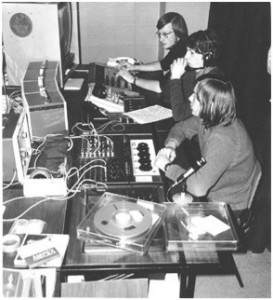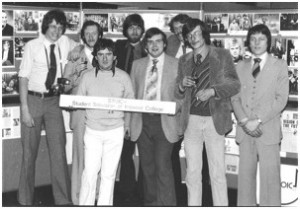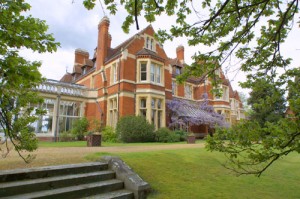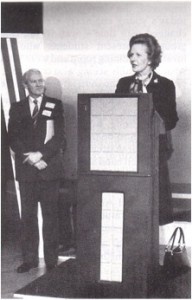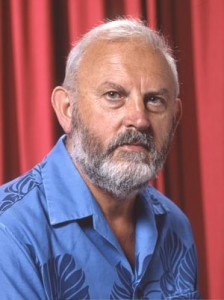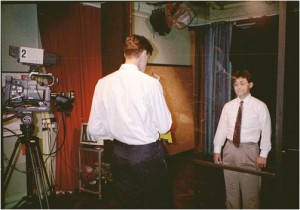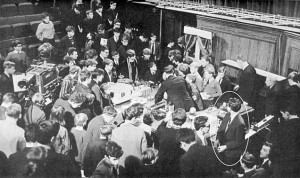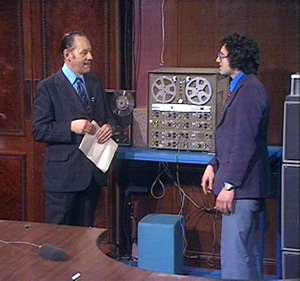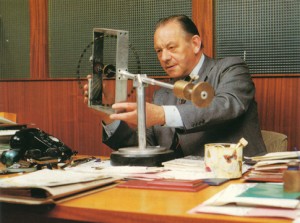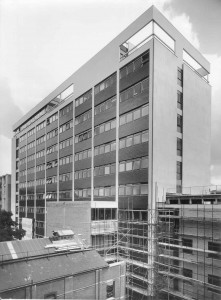
It’s not until you start to look at individual tapes in our archive that you realise how many different videos have, or could have, a link between them. In this latest blog I’ve found an example of that with two research videos made for the Electrical and Electronic Engineering Department ( Electrical Engineering Department as it was when these were made). We’ll also be seeing something of the actual department from the past. I should also point out that until 1976 were part of that department (a departmental facility) and as such located within the building. Our first location was on the 3rd floor moving to the main walkway level 2, where many of you may remember us.
In February 1981 Professor J.C Anderson (“Andy” Anderson 1922-2001) asked me to make a video showcasing the research in his Electrical Materials section within the department. I can’t recall the exact reason why we made the video, but am assuming it was to do with an open day, or similar, for Postgraduate research students, hence his references to getting PhD’s at the end of the video. The research going on at that time is shown and he makes reference to the work by Mino Green on Electrochromic Displays, but more on that in a moment.
Andy was very keen on the use of modern technologies for teaching, research and promotion and was the Chairman of the “Educational Technology Committee” (long since disbanded). It was his idea that I should be the only non-academic (although I was on the ‘academic related staff’) member of that committee to be able to update and advise on matters relating to the use of video within Imperial. He was not afraid to appear in front of the camera or, as in this case, record a voice-over as well. So here is the video we made with him: “Electrical Materials Research at Imperial College”
In the previous video, mention was made of the work by Professor Mino Green (1927-2022) (then Dr) on Electrochromic Displays. This work was already being carried out at the time of the previous recording. In fact the first video on Electrochromic Displays was made a year earlier in April 1980. We made some 7 videos on the subject with the last being in March 1993. I gather that Professor Green’s work has now moved away from such devices, but the concept was interesting and novel. The video itself is an example of how to show large numbers of people the research work being carried out by a small dedicated group. Even as long ago as 1980 we were having copies made into the American NTSC TV system to enable research work to be showcased in the USA, Mino Green’s was an example of this. Here is the video from 1993 on “Electrochromic Displays and Windows”.
Mino was an Emeritus Professor of the Science of Electrical Devices. His webpage described his work as “…The interplay of solid state physics and chemistry, particularly physical chemistry, has been an abiding interest. This has led through many areas, including semiconductor electrochemistry, chem- and physi-sorption on semiconductors, thermoelectric systems, solid state photo-and e-beam-decomposition, and transition metal oxide electrochromic systems. Now my main interests are in the larger end of nano-systems…”. In 1980 STOIC recorded an interview with Mino where he explains his area of research, you can see that video above.
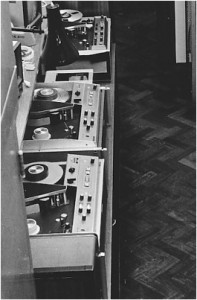
Finally for this particular blog I’ve pulled something out of the archive from 1978 and you’ll see that in just a moment. It was a video made to showcase the whole department rather than a particular division or research project. Again, I can’t recall the exact reason why we were asked to make the video, but assume it was either an open day or event with alumni for example. Open day is more likely as the video is dated June 1978. It was a major task to make too, as editing was primitive on our old Ampex open spool one-inch tape machines. Nothing was automatic and edit points were marked with white (‘chinagraph’) wax pencils onto the tapes directly, spooled back and then run up to speed for editing. Recently I re-discovered a tape, made in 1974, where we are showing what the studio could do. So, before we see that 1978 video, here I am in our original TV Studio number 1, showing briefly the Ampex recorder in use, which I can assure you was as heavy as it looked!
At this time, we had no real means to record outside of the studio. One option though was to link from a location back to the studio by cable. And, because we were located in the Electrical Engineering, the whole building had video cables running from the ground, to top floors. We then had the ability to run from a location point on each main floor, down to the studio and potentially elsewhere. In the end, cables were available to and from many different buildings around the South Kensington campus. However, by this time we had already gained the ability to record outside of the studio having just moved into colour operation on the U-matic tape format. Portable battery operation was then made possible. The video that follows is an example of this.
So back then to the video I made for Electrical Engineering . The video did require a voice-over, but could I get anyone to volunteer to record it for me? Well the answer was no and being at a stage of needing to start the editing I had to do it myself. That aside, the video is a unique record of the department showing its teaching and facilities. I was asked to make specific reference to the fact that every lecture room was equipped with an ‘overhead projector’, how times have changed! The department also had its own glassblower, electronics servicing and draftsman. Here then is a snapshot (in black and white) of the department as it was in the early summer of 1978.
Colin Grimshaw May 2010

